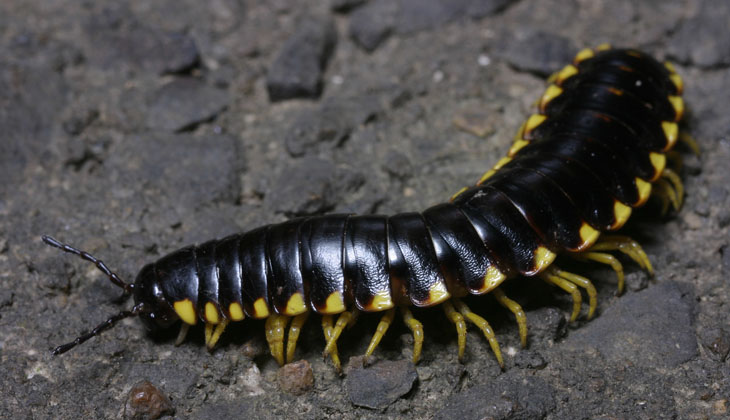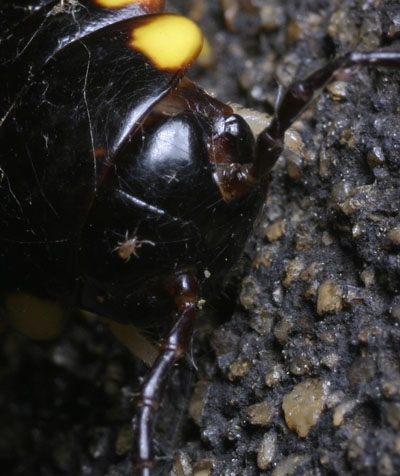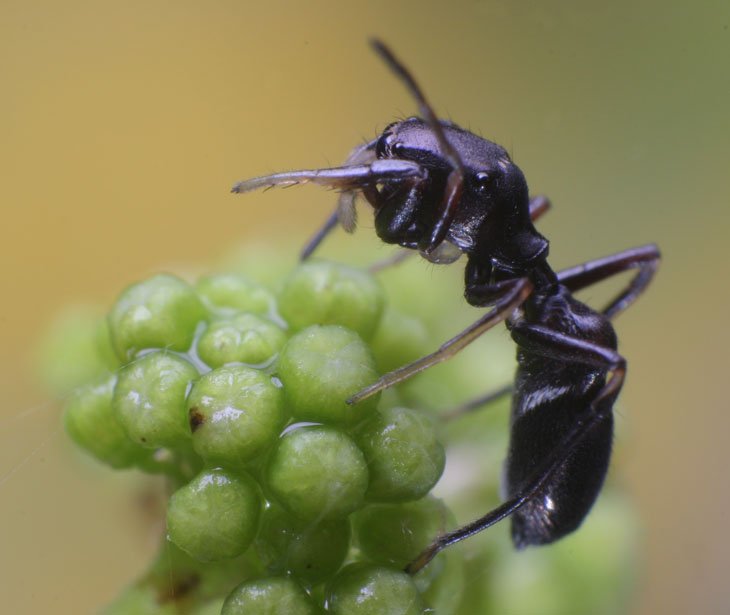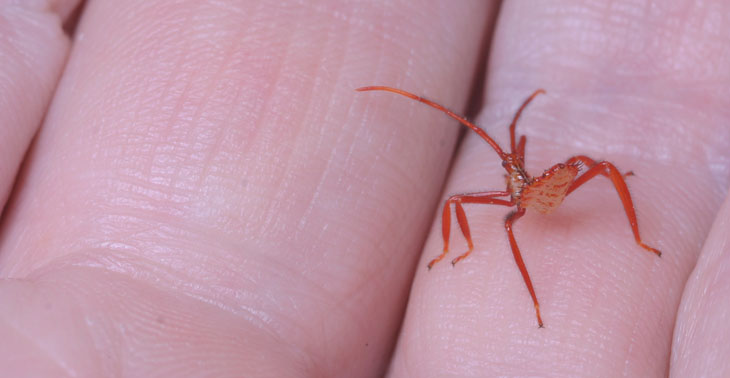
We’ve been seeing some steamy weather lately, high heat preceding wicked thunderstorms, and I was dumb enough to go down to the river in the former looking for subjects. Between bad sinus reactions and sweating buckets, without finding much of anything to shoot, I elected not to stay long. But I did bring back an eyed click beetle (Alaus oculatus) to get some more detail images of. These are among the largest beetles to be found in the area, this one hitting about 50mm, and completely innocuous. I had been hoping for one of these when doing the illustration for the Brain Bugs book review last year, but never located one.

The only other species I saw was an Apheloria virginiensis montana (I believe, anyway, though mine sported only faint dorsal spots, unlike every identifying image I’ve found for the species.) This one’s just a wee bit longer than the beetle above and fairly common around here, even though they don’t appear to have a common name. If you’ve ever heard the old chestnut about the smell of bitter almonds indicating cyanide, and wondered what this actually smelled like, handling one of these will provide the experience. Accurately, as well – they really do produce a cyanide compound as a predator repellent, so at least wash your hands immediately afterward. Those bright colors are yet another example of aposematic coloration, high-contrast warning colors to make the species memorable and easy to spot, once an unlucky predator has been unfortunate enough to get a mouthful of nasty secretions.
Quite a few species exhibit these traits, all utilizing the same basic combination of distinctive, contrasting colors and discouraging response; essentially, the repelling method creates an indelible learned memory, even in species not particularly known for reasoning skills, and the colors are distinctive enough to get connected to those memories, so predators learn that festive colors do not promise a good time. I had originally suspected that somehow, many species automatically recognized bright colors, because the learning method seems rather inefficient; most predators can do a lot of damage before any defensive response could take effect, meaning the organism could die despite their defense – it seems unlikely that this system could evolve effectively. But then there’s the problem of just how any predator would have evolved the idea that bright colors mean something bad in the first place, as well as the fact that any species would only have to develop the bright colors to protect themselves, and not any other form of defense.
 Carl Zimmer talks about this trait among poison arrow frogs in Costa Rica, which display significant color variations within a surprisingly small geographic area. Be sure to read the comments for more speculation about how the process works for these amphibians. Meanwhile, one of the images I got of my multipedal subject showed an enterprising mite traipsing across the cranium (as well as some spiderwebs.) This is the best image I have of it, unfortunately – the millipede was scaling the vertical concrete walls of the spillway, and I was standing on the submerged apron aiming straight down rather awkwardly while my subject was wandering unpredictably. In short, there weren’t a lot of options at hand for those conditions. The mite was discovered only after unloading the images once back home; I couldn’t have possibly spotted it in the viewfinder, but even if I had, I doubt I could have done much about it. It was bad enough getting the focus on the bobbing head of the millipede, without trying to catch the mite in its own perambulations…
Carl Zimmer talks about this trait among poison arrow frogs in Costa Rica, which display significant color variations within a surprisingly small geographic area. Be sure to read the comments for more speculation about how the process works for these amphibians. Meanwhile, one of the images I got of my multipedal subject showed an enterprising mite traipsing across the cranium (as well as some spiderwebs.) This is the best image I have of it, unfortunately – the millipede was scaling the vertical concrete walls of the spillway, and I was standing on the submerged apron aiming straight down rather awkwardly while my subject was wandering unpredictably. In short, there weren’t a lot of options at hand for those conditions. The mite was discovered only after unloading the images once back home; I couldn’t have possibly spotted it in the viewfinder, but even if I had, I doubt I could have done much about it. It was bad enough getting the focus on the bobbing head of the millipede, without trying to catch the mite in its own perambulations…

 A few days ago, I’d managed to capture another specimen I’ve been wanting more images of, an ant mimic jumping spider. Only about 5mm long, they really do appear like ants unless you know what to look for. For instance, they only have two body segments – spiders have a fused head and thorax, called a cephalothorax, while ants do not – but to me, it’s easier to spot them from their habits; spiders just move differently from ants. Especially this species, which is highly active for a spider and very difficult to capture in the tiny focus range of macro photography. These images were from my second attempt, the first yielding nothing worth keeping. And these are admittedly studio shots, using a sprig of grape buds held in an alligator clamp, with a little petroleum jelly on the base of the sprig to prevent the spider from escaping (on foot, anyway – there were a few tries at rappelling down on a web strand.) The background is a photo print, close enough to be lit by the same flash and softbox. While I could try to photograph this species in the wild, I know I would achieve nothing except drastically shortening my lifespan through stress and frustration. Police investigators now know, if they find someone dead in a field with a camera nearby, to check and see if a macro lens is attached. If so, the ruling is simply “natural causes” for nature photographers. And you thought the biggest hazards were bears and hippos…
A few days ago, I’d managed to capture another specimen I’ve been wanting more images of, an ant mimic jumping spider. Only about 5mm long, they really do appear like ants unless you know what to look for. For instance, they only have two body segments – spiders have a fused head and thorax, called a cephalothorax, while ants do not – but to me, it’s easier to spot them from their habits; spiders just move differently from ants. Especially this species, which is highly active for a spider and very difficult to capture in the tiny focus range of macro photography. These images were from my second attempt, the first yielding nothing worth keeping. And these are admittedly studio shots, using a sprig of grape buds held in an alligator clamp, with a little petroleum jelly on the base of the sprig to prevent the spider from escaping (on foot, anyway – there were a few tries at rappelling down on a web strand.) The background is a photo print, close enough to be lit by the same flash and softbox. While I could try to photograph this species in the wild, I know I would achieve nothing except drastically shortening my lifespan through stress and frustration. Police investigators now know, if they find someone dead in a field with a camera nearby, to check and see if a macro lens is attached. If so, the ruling is simply “natural causes” for nature photographers. And you thought the biggest hazards were bears and hippos…
 All of my attempts to pin down this species have failed so far, but I’m leaning towards a member of the genus Synemosyna. Anyone who can help out is invited to comment, or contact me directly – I may end up submitting them to BugGuide.net to see what their crew has to say. Meanwhile, this image remains my favorite, not because of any professional reason, but because the secondary strobe I was using for fill lighting provided a great sinister effect when the spider peered down in that direction – I suspect this is aided by the creepy position of the forelegs. What’s really happening, I believe, is the arachnid is collecting strands of its own silk and consuming it – this is a recycling trick of spiders (one of these days I’ll branch into video, but I don’t imagine that reducing stress in any way at all.) You can also see evidence of this same lighting technique in the first spider pic above, but I wasn’t using it for the second. Note the different reflections in the eyes, between the overhead softbox that illuminates the body chitin smoothly and the sharp reflections from the mini-strobe placed well below. While this subject might have benefited from the white box technique, I’ve had a lot of issues using that with reversed lenses, which pick up too much glare (lens coatings and structure are designed for using a lens the right way around…)
All of my attempts to pin down this species have failed so far, but I’m leaning towards a member of the genus Synemosyna. Anyone who can help out is invited to comment, or contact me directly – I may end up submitting them to BugGuide.net to see what their crew has to say. Meanwhile, this image remains my favorite, not because of any professional reason, but because the secondary strobe I was using for fill lighting provided a great sinister effect when the spider peered down in that direction – I suspect this is aided by the creepy position of the forelegs. What’s really happening, I believe, is the arachnid is collecting strands of its own silk and consuming it – this is a recycling trick of spiders (one of these days I’ll branch into video, but I don’t imagine that reducing stress in any way at all.) You can also see evidence of this same lighting technique in the first spider pic above, but I wasn’t using it for the second. Note the different reflections in the eyes, between the overhead softbox that illuminates the body chitin smoothly and the sharp reflections from the mini-strobe placed well below. While this subject might have benefited from the white box technique, I’ve had a lot of issues using that with reversed lenses, which pick up too much glare (lens coatings and structure are designed for using a lens the right way around…)
 My final subject is another specimen provided by The Girlfriend, who spotted it on her car and quickly captured it within a film can that she carries for expressly that purpose (yeah, I know, I’m a lucky little shit.) There is a chance this is actually the same species that she caught last year, just a much-younger nymph stage – still working on that bit. I initially considered it an assassin or wheel bug, judging from the body shape and proboscis; suffice to say it’s an Hemipteran (True Bug) who took advantage of some dew while I was set up to get the shots – every once in a while you get some nice cooperation. The spot in the eye is not evidence of my lighting technique, even though I just taught you how to look for this, but a pollen grain instead – another clue is that there are no other sharp highlights on the front surface of the legs, proboscis, or dewdrops.
My final subject is another specimen provided by The Girlfriend, who spotted it on her car and quickly captured it within a film can that she carries for expressly that purpose (yeah, I know, I’m a lucky little shit.) There is a chance this is actually the same species that she caught last year, just a much-younger nymph stage – still working on that bit. I initially considered it an assassin or wheel bug, judging from the body shape and proboscis; suffice to say it’s an Hemipteran (True Bug) who took advantage of some dew while I was set up to get the shots – every once in a while you get some nice cooperation. The spot in the eye is not evidence of my lighting technique, even though I just taught you how to look for this, but a pollen grain instead – another clue is that there are no other sharp highlights on the front surface of the legs, proboscis, or dewdrops.
I’ll close with a scale shot, purposefully done this way because it communicates the size so much better than giving length in millimeters – and because this was the only specimen that cooperated enough for an easy shot. The spider was many times smaller than this, while the click beetle and millipede were both about the length of my little finger. It provides an idea of the range of magnifications possible when pursuing arthropod images – which also indicates how much can be missed without looking closely.





















































